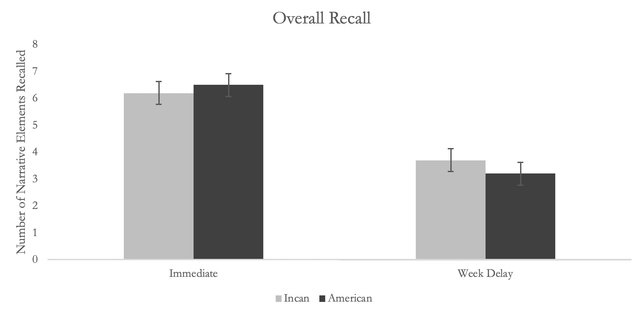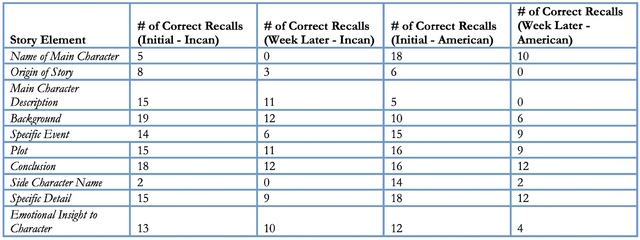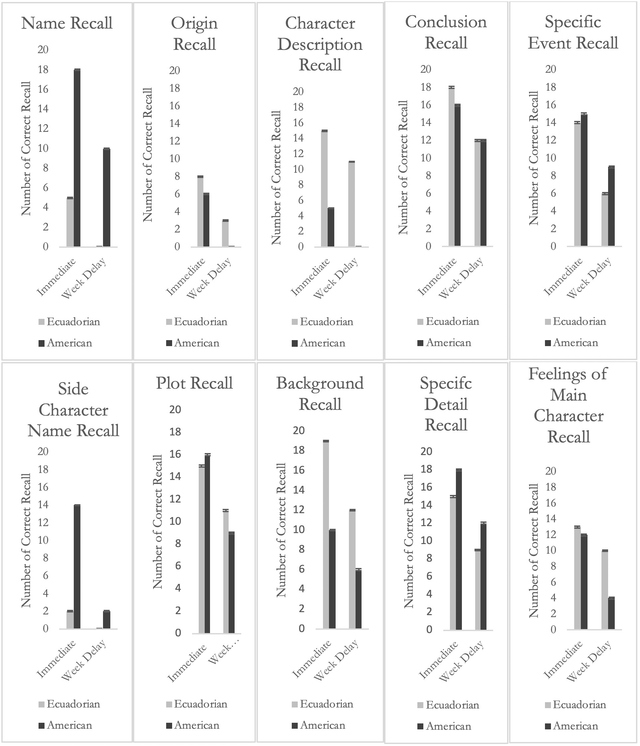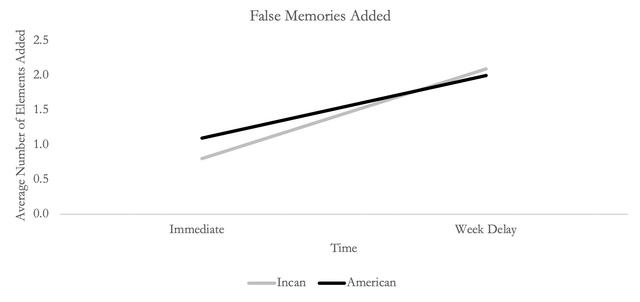Cross-Cultural Differences in Memory, Beliefs, and Mental Schemas
By
2021, Vol. 13 No. 02 | pg. 1/1
IN THIS ARTICLE
KEYWORDS
AbstractAlthough it is self-evident that one’s memories are often fleeting, a large amount of empirical research has been done within the field of cognitive psychology supporting the notion that one of the mind’s most extensive faults is its faculty for memory. Our memory system is, in a sense, defined through its shortcomings. It cannot store an unlimited amount of information, and because of this limitation, evolved to remember only what it deems relevant to the moment. Two questions necessarily follow this fact: what exactly makes something worth remembering, and how much of that thing is actually being remembered? One factor that influences this process is the knowledge we gain through experience, as it is our experiences that inform what we should attend to, what we value, and that shape our conditioned patterns of thinking. As Jean Piaget noted,1 the acquisition of knowledge is not a stagnant or fixed process, but a series of continuous adaptations to new information that can fit our environmental or cultural expectations. The content of one’s memories is evidence of these adaptations. It would not be necessarily true to state that people “recall” memories, as past experiences remembered in the present are never concrete reproductions of their original structure. Instead, these internal representations have gaps, and therefore, must be reconstructed. This is exactly the reason why there can be multiple interpretations of a single event when discussed between individuals. The current research attempted to recapitulate this idea using Frederick Bartlett’s model of reconstructive memory2 to further investigate the reliability of human memory. The experiment utilized two different stories of distinct cultural origins (one being a brief synopsis of Kurt Vonnegut’s Slaughterhouse Five; the other an ancient tale from Incan mythology titled “The Incan Goddess of Childbirth) that acted as the objects for memorization. Participants were read the stories one at a time by the researcher and were then asked to recall the content of the stories directly afterwards. This same request was asked of the participants one week later to analyze the effect of time on both memory recall and accuracy. Memory accuracy was operationalized by categorizing story structure into ten distinct elements that were shown to occur in both narratives. When compared to the immediate recall in both stories (M = 12.7, SE = 0.83), the precision of participant’s responses significantly decreased when recalled one week later (M = 6.9, SE = 0.70), F(1, 19) = 110.97, p < .001, η2 = .854. Furthermore, the average number of “false memories” found within participant’s responses greatly increased for both stories during the second recall (Incan - 62%, American - 55%). In addition, it was also noticed that many of our participant’s responses included common false memories that were shared between them, indicating the emergence of similar, underlying cultural assumptions that influenced the content of their memories. IntroductionThe content of people’s memories is greatly influenced by a collection of underlying personal beliefs, social pressures, biases and heuristics, and cultural assumptions3-6. The aggregate effect of all these influences working simultaneously is the formation of a schema; a mental framework that organizes information by their perceived relationships and associations. This organizational process is implicit and permeates all objects of our conscious experience. For example, humans share a common schema surrounding the concept of “dog,” which works something like this: animal, four legs, barks, wags tail, has fur, etc. These characteristics have been displayed in most of our prior interactions with dogs, and therefore, help us to form a shared, concrete, and uncontroversial schema of what “dog” is. However, not all schemas are universally accepted, and in fact, schemas often have discrepancies between individuals. A moment when this could occur, for example, is when a non-native is visiting a new country that has its own unique customs and social norms. In Japanese culture for instance, it is extremely offensive to tip waiters and waitresses. An American citizen (from a culture where tipping is not only a nice thing to do but expected behavior) visiting Japan could mistakenly tip a Japanese waiter, and in the process, not only offend him, but violate the waiter’s schema of “proper restaurant etiquette.” The American citizen (operating according to his own cultural schema), would believe they had done nothing wrong, and justify his offense by referring to the collection of memories he has in American restaurants, where tipping was continuously proven to be an act of courteousness and respect. This example is to demonstrate that our cultural upbringing can forge our belief systems and, specifically in this instance, the expectations of what we consider to be pro-social behavior.Interestingly enough, both of the individuals mentioned may also have differing accounts of how their exchange transpired. Not only would they probably remember the other to be rude or disrespectful, but their negative experience with the other could influence the accuracy in their description of that memory. Perhaps the American would recall his experience in general at the Japanese restaurant to be poor, where the overall service was poor, the food was both cold and overpriced, etc. Similarly, the Japanese waiter could remember the American to be continually bothersome throughout the night, and even believe other Americans to have acted rudely in other previous interactions. This phenomenon is known as false memories, where a person’s implicit associations or cultural assumptions prime the content of their memories, making them remember events that, in reality, never occurred at all. In addition, schemas not only influence memories, but future events as well. Once resolute beliefs about the world have been encoded, they prime all new encounters, where the characteristics of new images, people, and ideas are all seen through the lens of these established schemas. As the German philosopher Immanuel Kant once brilliantly observed, “We see things not as they are, but as we are”7. Therefore, it is important for us to recognize that schemas have a profound influence on our perceptions, and on a larger scale, create the generalized account of the world that can be seen through society’s formation of categories, identities, social roles, behavioral scripts, narrative archetypes, and, in the worst case, even stereotypes. For better or worse, these formations make complete sense from an evolutionary perspective. It requires much less mental effort to confabulate new information and change its overall structure, composition, and objective quality in order to secure a worldview that is both predictable and easily understandable8-9. This evolved mechanism is a cognitive heuristic known as the confirmation bias whereby individuals tend to interpret information in a manner that can affirm our current beliefs, assumptions, and identity10. It Because of this, any explicit memory could be considered more like an adaptation or opinion of some initial experience, caused by a variety of implicit cognitions that are, ultimately, beyond one’s own agency. It is for these reasons that what people are remembering (for instance, when told an arbitrary story,) may indicate a deeper truth about how narratives can change, specifically when the meaning that is derived from them is dependent upon the listener, rather than the factual content of the story itself. Frederic Bartlett was the first psychologist to investigate the reconstructive nature of memory through a famous study published in his book Remembering titled the “War of the Ghosts” experiment. In his study, Bartlett utilized a Native American legend that follows an “atypical” plotline when compared to the structure of traditional American stories (e.g. the departure-fulfillment-return model common to Western folklore11. Broadly speaking, American stories will follow a linear timeline where the “hero” is beckoned by the forces of nature to adventure into some new, unexplored territory where they must then conquer the greatest of evils and reestablish order in their society or world (although the prevalence of this structure has also appeared cross-culturally throughout history, such as in The Epic of Gilgamesh, the mythologies of Odysseus, Jesus Christ, The Buddha, and even modern “folk tales” like George Lucas’s Star Wars and J.R.R Tolkien’s Lord of The Rings12. In his experiment, Bartlett’s participants were read the legend, and after specific intervals of time, were asked to give a summarization of the plot. Their responses were then analyzed to evaluate what details of the story were memorized correctly, with the underlying assumption that what people found be more meaningful would be remembered more frequently, and “irrelevant” information would be omitted. What Bartlett noted from participant responses was two-fold. Firstly, after roughly two weeks had elapsed, almost every participant failed to recall important elements from the story correctly. Secondly, participants frequently added and altered story elements to “normalize” its content into a familiar, conventional structure (such as remembering “boats” rather than “canoes” and by “Westernizing” the main character’s names). Although it is unsurprising that memory accuracy decreased as more time elapsed, this experiment was the first to empirically demonstrate that one’s culture shapes the content of their memories. Bartlett’s research suggested that people will implicitly reconstruct new information to align with preexisting cultural assumptions. In the case of stories, culture plays an important factor in determining how they should be told, what elements they should include, and how they should be formatted. Watching this familiar structure unfold is psychologically satisfying to the observer or listener, and because of this, Bartlett concluded that individuals will unconsciously project this inherent schema onto a story if asked to recall it from memory. He noted that the process of memory “…is not the re-excitation innumerable fixed, lifeless, and fragmentary traces. It is an imaginative reconstruction or construction, built out of the relation of our attitude towards a whole active mass of organized past reactions or experience….” The current research is attempting to expand upon Bartlett’s model and further understand the reliability of memory, the effect of individual and cultural schemas, and the pervasiveness of these factors in the interpretations of various narratives. It utilizes two stories of different origins (one being a classic American tale, the other an ancient Incan myth) that will act as the objects for memorization to see if the prevalence of correctly recalled information and the addition of false memories is dependent upon inherent cultural frameworks. Participants recalled the stories immediately, and then one week later. The week delay helped us accomplish our secondary objective, which was to apply our results to real-world settings where the reciprocation of stories is fundamental to the success of their service. Methods and ProceduresParticipants for this study included 24 Albright College students who volunteered to participate in the experiment (although 4 people’s data could not be used due to not completing the second trial of the experiment). The final group that completed all parts of the experiment included 4 male and 16 female participants. The average age of the participants was 20.4 years old, with an age range of 19 to 23 years old (SD = 0.995). The ethnic background of the participants included 13 white/Caucasian, four Hispanic/Latino, and three black/African American. College student status was also considered, with 18 of the participants being traditional college students, while the other two were international college students. In addition, language proficiency was self-reported by each of the participants, with 18 stating that they were native, completely fluent speakers of English, while the other two considered themselves to be professional speakers. Two stories, originating from two different cultures, were used in this experiment; the first of which being an ancient story from Incan mythology titled “The Incan Goddess of Childbirth,” the second being a synopsis of Kurt Vonnegut’s Slaughterhouse Five. Both versions of the stories were paragraph-long summaries written by the researchers. During the experiment, the titles of each story were changed simply to “The Traveler” (Story 1) and “The Goddess” (Story 2) in order for the stories to retain anonymity. The important concepts of both stories were operationalized by categorizing ten distinct elements that occurred in both stories (Name of Main Character, Origin of Story, Main Character Description, Background, Specific Event, Plot, Conclusion, Side Character Name, Specific Detail, and Emotional Insight to Main Character). These elements represent the significant factors of both stories and are the main objects of memorization. The online survey platform, Qualtrics, was also used to collect participant’s responses throughout the course of the experiment. A laptop was provided to the participants during the initial trial of the experiment. Figure 1. Two paragraph-long short stories that were read to participants in succession of one another. The experiment utilized a 2 X 2 within-subjects design with the independent variables for the experiment being story type (Incan and American) and time (Initial and One Week Later). The dependent measures were story elements correctly recalled and false memories added. First, participants arrived at one of the Psychology labs on Albright College’s campus and were provided a laptop with a single textbox on the screen. They would then be asked to both memorize and summarize the following story, before being read either “The Traveler” or “The Goddess” by the experimenter. After the first story was read, participants were given an unlimited amount of time to type out a synopsis of what they had just heard. This same process was then repeated for the second story. After responses to the second story were given, participants were informed that after exactly one week, an email would be sent to them by the researcher requesting that they completed a follow-up trial of the experiment. In this second trial, participants were asked to similarly recall the major elements of both stories, although they were required to do this strictly from memory of the stories given a week prior. Participant’s memory was measured by the accuracy and prevalence of the operationalized elements, as well as the addition of false memories in their responses. All responses were collected via Qualtrics. ResultsA 2 (Story Type) X 2 (Time) two-way repeated measures ANOVA was used to analyze the effects of story type (Incan vs. American) and time (Initial recall vs. One Week Later) on the accuracy of memory. There was a main effect of time, F(1, 19) = 110.97, p < .001, η2 = .854, where the initial recall of the 20 total elements (ten per story) produced significantly more correct responses (M = 12.7, SE = 0.83) than the recall one week later (M = 6.9, SE = 0.70). There was no main effect of story, however, there was a nearly significant interaction between story type and time, F(1, 19) = 3.24, p = .088, η2 = .145. Table 1. Number of correct recalls for each story depending upon story being told and time it was recalled. Figure 2. Number of correct recalls for each story depending upon story being told and time it was recalled. Post-hoc analysis was done on each of the elements of the stories individually (e.g. Main Character, Origin of Story, Main Character Description, etc.). The table below depicts the number of correct recalls amongst all participants depending upon the story being told and the time it was recalled. Recollection of Name of Main Character was significantly affected by both story type F(1, 19) = 47.64, p < .001, and time, F(1, 19) = 18.78, p < .001. Participants recalled the main character’s name more easily in the American story and recalled both main character names better during immediate recall. Recollection of Origin of Story was significantly affected by time, F(1, 19) = 7.69, p = .012. In both stories, participants recalled the origin of the story better during the immediate recall. Recollection of Main Character Description was significantly affected by story type, F(1, 19) = 24.72, p < .001, and time, F(1, 19) = 11.07, p = .004. Participants recalled the main character’s characteristics more easily in the Incan story and recalled both descriptions better during immediate recall. Recollection of Background was significantly affected by story type, F(1, 19) = 21.92, p < .001, and time, F(1, 19) = 16.54, p = .001. Participant’s recalled background information more easily in the Incan story and recalled the background of both stories easier in the immediate recall. Recollection of Specific Event was significantly affected by time, F(1, 19) = 18.26, p < .001. In both stories, recollection of a specific event was recalled more easily during the immediate recall. Recollection of Plot was significantly affected by time, F(1, 19) = 10.50, p = .004. In both stories, recollection of main elements of the plot were recalled more easily during the immediate recall. Recollection of Conclusion was significantly affected by time, F(1, 19) = 13.57, p = .002. In both stories, recollection of the conclusion of each story was recalled more easily during the immediate recall. Recollection of Side Character Name was significantly affected by story type, F(1, 19) = 18.26, p < .001, time, F(1, 19) = 30.03, p < .001, and the interaction between story and time, F(1, 19) = 13.57, p = .002. Participants recalled the side character’s name more easily in the American Story and was also significantly remembered more during the immediate recall than the Incan story. However, in the secondary recall a week later, both stories side characters were rarely recalled. Recollection of Specific Detail was significantly affected by time, F(1, 19) = 15.56, p = .001. In both stories, recollection of a specific detail of each story was recalled more easily during the immediate recall. Finally, recollection of Emotional Insight to Character was significantly affected by time, F(1, 19) = 12.84, p = .002, and was nearly significantly affected by the interaction between story type and time, F(1, 19) = 4.13, p = .056. . In both stories, recollection of the internal feelings associated with the main character of each story were recalled more easily during the immediate recall. In addition, during the secondary recall a week later, the feelings of the Incan main character were recalled more often than the American main character. Recollection of Name of Main Character was significantly affected by both story type F(1, 19) = 47.64, p < .001, and time, F(1, 19) = 18.78, p < .001. Participants recalled the main character’s name more easily in the American story and recalled both main character names better during immediate recall. Recollection of Origin of Story was significantly affected by time, F(1, 19) = 7.69, p = .012. In both stories, participants recalled the origin of the story better during the immediate recall. Recollection of Main Character Description was significantly affected by story type, F(1, 19) = 24.72, p < .001, and time, F(1, 19) = 11.07, p = .004. Participants recalled the main character’s characteristics more easily in the Incan story and recalled both descriptions better during immediate recall. Recollection of Background was significantly affected by story type, F(1, 19) = 21.92, p < .001, and time, F(1, 19) = 16.54, p = .001. Participant’s recalled background information more easily in the Incan story and recalled the background of both stories easier in the immediate recall. Recollection of Specific Event was significantly affected by time, F(1, 19) = 18.26, p < .001. In both stories, recollection of a specific event was recalled more easily during the immediate recall. Recollection of Plot was significantly affected by time, F(1, 19) = 10.50, p = .004. In both stories, recollection of main elements of the plot were recalled more easily during the immediate recall. Recollection of Conclusion was significantly affected by time, F(1, 19) = 13.57, p = .002. In both stories, recollection of the conclusion of each story was recalled more easily during the immediate recall. Recollection of Side Character Name was significantly affected by story type, F(1, 19) = 18.26, p < .001, time, F(1, 19) = 30.03, p < .001, and the interaction between story and time, F(1, 19) = 13.57, p = .002. Participants recalled the side character’s name more easily in the American Story and was also significantly remembered more during the immediate recall than the Incan story. However, in the secondary recall a week later, both stories side characters were rarely recalled. Recollection of Specific Detail was significantly affected by time, F(1, 19) = 15.56, p = .001. In both stories, recollection of a specific detail of each story was recalled more easily during the immediate recall. Finally, recollection of Emotional Insight to Character was significantly affected by time, F(1, 19) = 12.84, p = .002, and was nearly significantly affected by the interaction between story type and time, F(1, 19) = 4.13, p = .056. . In both stories, recollection of the internal feelings associated with the main character of each story were recalled more easily during the immediate recall. In addition, during the secondary recall a week later, the feelings of the Incan main character were recalled more often than the American main character. Because participants wrote out the stories themselves for the measure of recall, we were also able to analyze false memories – additional or changed details that were not found within the original story. False memories were significantly affected by time, F(1, 19) = 24.46, p < .001, where the amount of false memories added into participant’s responses was significantly greater one week later than in the initial trial. The table below depicts the breakdown of false memories added amongst all participants depending upon story type and the time of recall. Figure 3. Breakdown of the total recollection of all narrative elements depending upon story type and time of recall. Table 2. Average and total number of false memories added to each story depending upon story being told and time it was recalled. Figure 4. Average number of false memories added in participant responses depending upon story type and time of recall. DiscussionThe main finding of the study was that the accuracy of participant’s responses significantly decreased when recalled one week later compared to the immediate recall for both stories. Compared to the average accuracy of 63.5% in participant’s immediate responses, the secondary recall elicited an average recall accuracy of 34.5%, meaning that participants only remembered half as much as they did initially. Recall accuracy was, of course, gauged by analyzing the number of correctly recalled story elements in participant responses for both stories. This finding was able to give us a general quantitative measure of memory that demonstrates, objectively, how memories become more unreliable as more time passes. Although this fact sounds rather trivial, understanding the general rate of memory distortion is extremely important to recognize. Firstly, any field reliant on the accuracy of one’s memories must account for its unreliability. If only about one third of the story elements were recalled correctly after just one week, we can assume that this number would continue to decrease as more time elapsed. Furthermore, these results should not apply solely to this experiment, but all of our memories. Generally speaking, the more time that passes between an initial experience and the moment of its recollection, the less likely the experience will be remembered fully, and the more likely it becomes that any summary of the experience would deviate from its original structure. Becoming aware of these faults may lead to better self-understanding, decision-making, and conflict resolution when memories are collectively in dispute. Secondly, since participants were informed by the researchers that they were participating in an experiment studying memory, it was believed that the participants would be listening to the stories with the focused intention of memorization (and therefore, bestow upon the stories a large degree of attention, importance, meaningfulness, etc.). The perceived “meaningfulness” of new information can significantly affect the amount and accuracy of what is remembered, and so the experiment itself primed the idea that these stories were something to be remembered13. Therefore, these results may indicate that memory recall is extremely inaccurate even with information that is, for whatever reason, deemed important or meaningful. The recall accuracy of most of the story elements were only affected by time, suggesting that there was nothing about the story elements themselves that lead to better or worse recall. In other words, it is not clear if the inaccurate reconstruction of all story elements were reflective of underlying cultural assumptions or established schemas. However, some elements were remembered much better than others, and differences seen amongst story elements in participant responses was also noticed. For example, the Name of Main Character and Side Character Name were remembered significantly more often in the American story than the Incan myth. This is most likely due to the majority of our participant’s familiarity with “American names,” which would be more easily recognized and recalled due to prior experiences with the phonetics of the English language, or even the names themselves. Also, the name “Billy” is linguistically simpler than “Cavalace,” which could have also affected this difference (although “Valencia” is arguably a more complex American name, but the same trend was noticed). Therefore, it could be said that not all information is memorized the same, and this difference in memory is reflective of our participant’s underlying expectations for character names. A second example of potential schema projection was demonstrated in the significant difference in Main Character Description between stories, whereby the character’s description in the Incan myth was remembered more easily than the American character’s description. This was possibly due to the nature of the description themselves. The Incan myth’s main character, Cavalace, was described as a “goddess” and “being the most beautiful in the land,” while the American main character, Billy, was described as “weak” and “awkward.” These aspects were potentially remembered more clearly in the Incan myth because of their positive nature. In general, the main character of almost every great narrative is portrayed to reflect positive personal characteristics or virtues (like beauty, goodness, purity, wisdom, etc.). In addition, the appearance of a mysterious goddess that possesses great amounts of beauty and wisdom is a reoccurring character featured in many popular stories throughout history. For example, this occurs in almost every Disney movie (e.g. the “Disney Princesses”) and perhaps the ubiquity of the “archetypal Goddess” would make it much more recognizable (and, by consequence, memorable) than something like the “pathetic hero.” In addition, there was a significant difference in Character Background, where Cavalace’s background was remembered much more frequently than Billy’s in both the initial and secondary recall. The primary reason for this is still uncertain, and open to further speculation. It may, perhaps, be due to our fundamental association of women with pregnancy. Although the events surrounding Cavalace’s pregnancy are certainly bizarre, the idea of a female character becoming pregnant through extraordinary circumstances is extremely common in narratives (such as the account of Mary within the Biblical stories, as well as almost every female character found in Grimms’ Fairy Tales). Therefore, the familiarity of this character-type may have aided in the remembrance of the objects surrounding her pregnancy (like the appearance of the man, the tree, the fruit, and so on,) compared to the background of Billy which is much more varying and unfamiliar. However, this justification is still open to more hypothesizing. In our analysis of false memories, we were able to observe that the amount of false memories added in participant responses significantly increased during the secondary recall. The prevalence of information added in our participant’s responses (information that was never stated in the original telling of each story) nearly doubled for both stories. Interestingly enough, we also found that many participant’s responses contained common false memories shared between them. As it is extremely unlikely that these participants communicated with each other on what they had written, these common themes could be attributed to shared assumptions about stories that are products of established cultural schemas. These shared false memories also occurred in both stories to similar degrees. For example, in their responses of the Incan myth, participants wrote that Cavalace ate specifically an “apple” instead of simply a “fruit” 13 times out of the 40 total responses. Other false memories added to the Incan myth included Cavalace journeying off to a remote island (mentioned a total of nine times), as well as her nationality being of “Greek” origin instead of “Incan” (which was mentioned a total of ten times). This same trend similarly occurred in the American story with the interchanging of “the Russians” and “the Germans” (mentioned a total of 14 times), as well as heroic characteristics being added to the description of Billy (mentioned a total of ten times). In addition to this, there were specific instances in individual's responses that clearly suggested the influence of a pre-existing cultural schemas (such as Cavalace eating the “poisoned worm in the apple” or Billy himself “defeating the German forces.” Further review of participant responses could reveal additional moments of variation indicative of cultural expectations effecting memory, but researchers believed these examples would suffice for a primary analysis. ConclusionThe current research was conducted as a variation of Bartlett’s experiment to obtain an objective measure of human memory’s accuracy, and to evaluate why certain information is memorized more easily than others. This research has future implications to any domain heavily reliant upon memory recall and accuracy. As mentioned previously, one pillar of our judicial is the accuracy of witness testimony, making the reasonableness and credibility of an investigation dependent on consistency between multiple narratives. Similarly, the effectiveness of public discourse is predicated upon how events of the past are being remembered and the “narratives” that are constructed about them. Resolving complicated social issues may be, in part, due to our own evolutionary shortcomings which prevent the mind from remembering the world in a truly “objective” manner. Therefore, as more time passes, more factors can influence the quality of what one is remembering about certain events, allowing for the truth to be reinterpreted repeatedly, leading to the collective hysteria and cognitive dissonance we are experiencing in political discussion today. More specifically, however, we wanted this research to be applied further to a psychotherapeutic setting. As previously stated, research has suggested that a person’s autobiographical memories are similarly influenced by these mental errors and cognitive biases14. From this, individual construct “self-schemas” which pre-define how one should feel, the behaviors they should exhibit, and the beliefs they should have. One of the most consistent features of those afflicted by mental suffering is their skewed interpretations of past experiences. Whether these experiences are distorted, exaggerated, catastrophized, or degraded, there is a common theme of rumination within these personal stories, and those stories simultaneously will negatively influence the person’s perception of current life events15. Patients who understand that their memories (even memories that are extremely painful to those people,) are not completely accurate reconstructions of the past may find comfort knowing those thoughts are reflections of their current mental state and should, therefore, not to be ruminated upon. Additionally, individuals with a fractured self-concept or low self-esteem tend to remember their past experiences by “everything that went wrong,” and will then both focus on and exaggerate moments of embarrassment, discomfort, and suffering. Individuals will then be unwilling to accept any narrative that does not coincide with what they already believe to be true about themselves, and therefore, psychotherapists must seek to change these narratives to promote psychological healing using tools like reappraisal, mindfulness, and self-awareness16. The illusive nature of memory is, therefore, something that we must continually be aware of to increase success in multiple societal domains. AcknowledgementsThe author thanks the Albright Creative Research Experience and Albright College’s Psychology Department for funding and providing him with the opportunity to engage in independent research. He would also like to thank Dr. Justin Couchman for his continuous mentorship and inspiration. References1. Piaget, Jean. (1952). The Origins of Intelligence in Children. New York: International Universities Press 2. Bartlett, F. S. (1932). Remembering: A Study in Experimental and Social Psychology. Cambridge University Press. 3. Axelrod, R. (1973). Schema Theory: An Information Processing Model of Perception and Cognition. American Pol itical Science Review, 67(4), 1248-1266. https:/ / doi:10.2307/1956546 4. Dooling, D. J., & Christiaansen, R. E. (1977). Episodic and semantic aspects of memory for prose. Journal of Experimental Psychology: Human Learning and Memory, 3(4), 428-436. https:/ /doi:10.1101/lm.94705 5. Gallo, D. A. (2010). False memories and fantastic beliefs: 15 years of the DRM illusion. Memory & Cognition, 38(7), 833-848. https:/ / doi:10.3758/mc.38.7.833 6. Miron-Shatz, T., Stone, A., Kahneman, D. (2009). Memories of yesterday's emotions: Does the valence of experience affect the memory-experience gap?Emotion, 9(6), 885-891. https://doi.org/10.1037/a0017823 7. Kant, I., Guyer, P., & Wood, A. W. (1998).Critique of pure reason. Cambridge; New York: Cambridge University Press. 8. Schacter, D. L. (2012). Adaptive constructive processes and the future of memory.American Psychologist, 67(8), 603–613.https://doi.org/10.1037/a0029869 9. Schacter, D. L. & Barney S. (2014). Implicit memory, constructive memory, and imagining the future: A career perspective. Perspectives on Psychological Science, 14(2), 256-272. https://doi.org/10.1177/1745691618803640 10. Nickerson, Raymond (1998). Confirmation bias: A ubiquitous phenomenon in many guises. Review of General Psychology, 2(2), 175-220. https:// doi.org/10.1037/1089-2680.2.2.175 11. Campbell, J. (1949). The Hero With a Thousand Faces. New York, NY, US: Pantheon Books. 12. Northup, Lesley (2006). Myth-placed priorities: Religion and the study of myth. Religious Studies Review, 32(1), 5-10. https://doi.org/10.1111/j.1748-0922.2006.00018.x 13. Laney, C., & Loftus, E. F. (2009). Truth in Emotional Memories. Emotion and the Law Nebraska Symposium on Motivation, 157–183. doi: 10.1007/978-1-4419-0696-0_6 14. Troy, A. S., Shallcross, A. J., Brunner, A., Friedman, R., & Jones, M. C. (2018). Cognitive reappraisal and acceptance: Effects on emotion, physiology, and perceived cognitive costs. Emotion, 18(1), 58-74. doi:10.1037/emo0000371 15. Ysseldyk, R., Matheson, K., & Anisman, H. (2007). Rumination: Bridging a gap between forgivingness, vengefulness, and psychological health. Personality and Individual Differences, 42(8), 1573–1584. doi: 10.1016/j.paid.2006.10.032 16. Schachter, S., & Singer, J. (1962). Cognitive, social, and physiological determinants of emotional state.Psychological Review, 69(5), 379-399. doi:10.1037/h0046234 Suggested Reading from Inquiries Journal
Inquiries Journal provides undergraduate and graduate students around the world a platform for the wide dissemination of academic work over a range of core disciplines. Representing the work of students from hundreds of institutions around the globe, Inquiries Journal's large database of academic articles is completely free. Learn more | Blog | Submit Latest in Psychology |
























